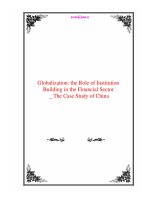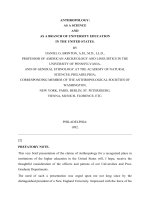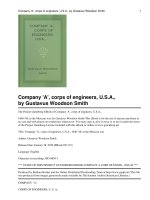wandering in the gardens of the mind peter mitchell and the making of glynn
Bạn đang xem bản rút gọn của tài liệu. Xem và tải ngay bản đầy đủ của tài liệu tại đây (2.37 MB, 342 trang )
W andering in the gardens of the mind
John Prebble
Bruce Weber
Foreword by Sir Tom Blundell
W
andering in the
1
2003
peter mitchell
and
the making of glynn
Gardens of the Mind
1
Oxford New York
Auckland Bangkok Buenos Aires Cape Town Chennai
Dar es Salaam Delhi Hong Kong Istanbul Karachi Kolkata
Kuala Lumpur Madrid Melbourne Mexico City Mumbai
Nairobi São Paulo Shanghai Taipei Tokyo Toronto
Copyright © 2003 by Oxford University Press, Inc.
Published by Oxford University Press, Inc.
198 Madison Avenue, New York, New York 10016
www.oup.com
Oxford is a registered trademark of Oxford University Press
All rights reserved. No part of this publication may be reproduced,
stored in a retrieval system, or transmitted, in any form or by any means,
electronic, mechanical, photocopying, recording, or otherwise,
without the prior permission of Oxford University Press.
Library of Congress Cataloging-in-Publication Data
Prebble, John, 1944–
Wandering in the gardens of the mind :
Peter Mitchell and the making of Glynn /
John Prebble, Bruce Weber.
p. cm.
Includes bibliographical references and index.
ISBN 0-19-514266-7
1. Mitchell Peter Dennis. 2. Glynn Research Institute. 3. Biochemists—
England—Biography. I. Weber, Bruce, 1941— II. Title.
QP511.8.M58 P73 2002
572′.092—dc21 2002075411
[B]
987654321
Printed in the United States of America
on acid-free paper
To Pat and Kathy
Preface
In many ways, biological science came of age in the twentieth century.
Among the large number of scientists who brought about the new un-
derstanding of living things was Peter Mitchell (1920–1992). Mitchell is
important in twentieth-century biology because he was the major figure
responsible for bringing about a paradigm change in biochemical think-
ing about metabolic energy and discovering the link between metabolic
energy and the transfer of substances across membranes. He himself
undertook something of a crusade in the 1950s in trying to bring to-
gether thinking about physiological transport across membranes and
thinking about the general metabolism of cells largely conceived as tak-
ing place in undifferentiated solution. While Mitchell regarded his ideas
on the relation between transport and metabolism as his major contri-
bution, the world remembers him for a derivative of these ideas—the
chemiosmotic theory developed in the 1960s and 1970s. This theory
explained a phenomenon, which had baffled biochemists since Engel-
hardt, Kalckar, Ochoa, and others first described the process of oxida-
tive phosphorylation, whereby metabolic energy of oxidation is con-
served as ATP (adenosine triphosphate), the energy currency of the cell.
There are other reasons for writing a biography of Mitchell. Apart
from developing the chemiosmotic theory, which solved a long-stand-
ing problem, he engaged in other creative activities. Endowed with
family money, he set out to prove that it was still possible to set up and
run a small independent research institute, the Glynn Research Insti-
tute. This he did with his lifelong associate, Jennifer Moyle. The award
of the Nobel Prize in Chemistry to Mitchell in 1978 not only provided
recognition of his contribution to biochemistry but also, at least in his
eyes, justified the existence of the institute. To date, there have been two
biographies of Mitchell: a short authoritative Royal Society biographical
memoir by Bill Slater and a short unpublished manuscript by Milton
Saier.
Essentially, Mitchell is that rare breed of scientist, a theoretical biolo-
gist. He believed in thinking about science almost as an activity in its own
right, and, unlike his older contemporary Hans Krebs, Mitchell proposed
complex theories before proceeding to test them. The words of our title ap-
pear on a plaque in the garden of remembrance created by Helen Mitchell
and reflect the spirit with which Peter Mitchell approached biology.
All of these aspects of Mitchell’s life, and many others, are why we
feel a life of Peter Mitchell is needed. The history of the remarkable
achievements of twentieth-century biochemistry is only beginning to be
written, with but a few biographies so far published. It is our intention
that this biography of Peter Mitchell will tell one important story of this
stream of human endeavor.
One of us (J. P.) first heard Peter Mitchell lecture in 1956 and was
fascinated by his approach to biological thinking. Although he heard
him lecture many times over the years, he did not get to know Mitchell
until late in his life. The other (B. W.) first interviewed Mitchell in 1979
and carried out many more interviews over the ensuing years. Both of
us have interviewed, and corresponded with, many biologists and
members of the family over recent years. We owe a great debt to those
who had the patience and were prepared to give time to answering our
questions and telling us about Mitchell. We are especially indebted to
Mrs. Helen Mitchell for her interest, encouragement, and help and to
Dr. Jennifer Moyle for her help. We would also like to record our appre-
ciation of the advice offered by Professor Mårten Wikström (University
of Helsinki) on chapters 9 and 11 and to Dr. Harmke Kamminga (Uni-
versity of Cambridge) on chapters 3 and 4.
The biography is based primarily on interviews with Mitchell himself,
discussions with scientists who knew him, and his published papers, but
particularly on the extensive files of letters and other papers he left when
he died. While this work has been proceeding, Mitchell’s papers have now
been catalogued and are housed in the library of the University of Cam-
bridge. The letters are mostly from the Glynn period (1964–1992), although
there are some from earlier years. Thus the major resource for the early pe-
riod has been interviews, while the later years have relied heavily on
archives, principally Mitchell’s archives, but we have also drawn to a
preface
viii
limited extent from Professor E. C. Slater’s archives at Haarlem in the
Netherlands. Wherever possible, significant points have been confirmed
from more than one source, and we have consulted published records such
as the Cambridge University Reporter for the Cambridge period (1939–1955).
Mitchell was a very complex person, and we have discovered
people’s memories of events in which he was involved, and their feel-
ings about him, vary widely. We offer this biography as our best inter-
pretation of his life on the basis of the material available to us, but
we are aware that some of his contemporaries will have different
views.
Mitchell left relatively few laboratory notes, and the ones we found
are almost exclusively from the Edinburgh period (1956–1963). He did
not keep good records of his experiments, and those that have survived
are sketchy; they can be interpreted only with difficulty and some un-
certainty. They were originally housed in binders, but by the time we
saw them in the last days of the Glynn Research Institute, they were al-
most all loose and mostly undated. During the Glynn period, the labo-
ratory notes were probably kept exclusively by Jennifer Moyle, who, re-
grettably, has forbidden access during her lifetime.
There are special problems about writing a scientific biography of a
twentieth-century scientist, which relate to the nature of the science.
While the central reason for writing about Mitchell is the achievement
of his science, the essential character of that science itself is not easily
conveyed to the reader because of its extremely technical nature. We
have endeavored to simplify the biochemistry but realize that, to bio-
chemists, we will be seen to have glossed over, and on occasions mis-
represented, important details of Mitchell’s and also other scientists’
work. We also appreciate that our attempts to eliminate the technical
detail may not have gone far enough for some readers, and, to give
some assistance to them, we have added an appendix on the theories of
oxidative phosphorylation.
We would like to acknowledge the help of Dr. Peter Rich, who suc-
ceeded Peter Mitchell as director of the Glynn Research Institute and
who gave us access to Mitchell’s papers before they were transferred
to Cambridge. The many others who have given us their time, advice,
and support are listed in the acknowledgments. Their generosity and
friendship are greatly appreciated. We are indebted to our editor, Kirk
Jensen, and his colleagues at Oxford University Press for their help.
Finally we are most grateful to Professor Sir Tom Blundell for
preface
ix
agreeing to write the foreword to this work in which he has shown in-
terest and given encouragement.
Royal Holloway, University of London J. P.
California State University, Fullerton B. W.
and Bennington College, Vermont
October 2001
preface
x
A cknowledgments
We express our appreciation to the following for giving us interviews:
Angelo Azzi
Giovanni Azzone
Harold Baum
Paul Boyer
Martin Brand
Marie Cassidy
Britton Chance
Brian Chappell
Tony Crofts
James Danielli
Mary Danielli
Helen Davies
Robert Davies
David Deamer
Lars Ernster
Peter Garland
Keith Garlid
David Green
Edward F. Hartree
Y. Hatefi
Julia Heffer (née Mitchell)
Peter Hinkle
Eva Ibbotson
Baz Jackson
André Jagendorf
Hermann Kalckar
Douglas Kell
Sir John Kendrew
Arnost Kleinzeller
Margot Kogut
C. P. Lee
Albert Lehninger
Alan Maddy
Aubry Manning
Vanessa Martin
Eileen McNeil (formerly
Eileen Mitchell)
Helen Mitchell
Jeremy Mitchell
Peter Mitchell
Murdoch Mitchison
Harold Morowitz
Jennifer Moyle
Don Northcote
Sam Perry
Max Perutz
Lord George Porter
Ef Racker
Bob Reid
Bryan Robertson
Daniel Robertson
Sir Rutherford Robertson
We would also like to acknowledge those who corresponded with
us about Peter Mitchell: Ernest Gale, Eva Ibbotson, Yasuo Kagawa, Joan
Keilin-Whiteley, James Moore, Harold Morowitz, Jennifer Moyle, Sandy
(A. G.) Ogston, Sir Rudolph Peters, Sir Rutherford Robertson, Bill (E.
C.) Slater, Nobuhito Sone, Ian West, and Mårten Wikström.
We wish to acknowledge financial support from the American
Philosophical Society (B. W.), Burroughs-Wellcome (B. W.), the National
Science Foundation (B. W.), and the Wellcome Trust (J. P.).
We express our appreciation to those who kindly read all or part of
the manuscript: David Depew, Chuck Dyke, Ann Marshall, Gideon
Mitchell, Harold Morowitz, Jack Pridham, and Peter Rich. However,
any errors are solely our responsibility.
We are grateful to those who have given permission to reproduce
material from their published work or letters to Mitchell or others: Hel-
mut Beinert, Paul Boyer, Britton Chance, Brian Chappell, Michael Gor-
don, Franklin Harold, Peter Hinkle, Andre Jagendorf, Jennifer Moyle,
Sergio Papa, Gottfried Schatz, Bill (E. C.) Slater, Ian West, Mårten Wik-
ström, and Bob (R. J. P.) Williams. We acknowledge the permission of
the Cambridge University Library to reproduce material from Peter
Mitchell’s letters and unpublished material.
Finally, we wish to thank Professor Britton Chance and Dr. Helen
Davies for copies of letters and Mrs. Helen Mitchell for her diary of the
Nobel Prize celebrations and Peter Mitchell’s diary for the refurbish-
ment of Glynn.
a cknowledgments
xii
Fred Sanger
Vladimir Skulachev
Bill (E. C.) Slater
Jui Wang
Ian West
Mårten Wikström
Bob Williams
John Wrigglesworth
Contents
Foreword, by Sir Tom Blundell xv
Chronology xix
1 Prologue: Who Was Peter Mitchell? 3
2 Early Years and Education: 1920–1939 10
3 The Early Cambridge Years: 1939–1947 24
4 Research at Cambridge: 1947–1955 44
5 Edinburgh: 1955–1963 64
6 The Creation of Glynn: 1962–1965 96
7 Testing the Theory: 1965–1968 115
8 Exploring the Implications of the Theory: 1969–1973 146
9 Getting the Arithmetic Right: 1974–1976 170
10 From Review to Nobel Prize: 1977–1978 195
11 The Cytochrome Oxidase Controversy: 1977–1986 222
12 Science for Humanity: 1985–1992 248
13 Epilogue: Mitchell and Glynn 269
Appendix: Theories of Oxidative Phosphorylation 278
Notes 285
Index 307
Foreword
The popular image of science bears little relationship to what most in-
novative scientists do. Stories in the newspapers often depict science as
strong on authority, reinforcing the image of the scientist as an expert
who can reveal truths that are unassailable and unalterable.
1
Science
writers who use a detective story approach to scientific explanation re-
inforce the same sense of certainty. Many science students consider sci-
entific theories to be unchanging and offer exact predictions. Scientific
experiments are often considered exercises that have a right answer that
students fail to deliver most of the time.
2
Science is characterized as
from unanswered questions to unquestioned answers.
For those who have such views of science, this biography will
come as a shock. Peter Mitchell was a larger-than-life individual who
changed the way we think about the key processes of energy metabo-
lism and membrane transport in living organisms. His work was
surrounded by controversy and uncertainty. For several decades two
theories—or perhaps more correctly, hypotheses—competed with his
for recognition, in what was known as the “ox phos wars.” Mitchell and
his talented experimentalist coworker, Jennifer Moyle, had to repeat
many of the experiments on which they had based their theory as they
were challenged elsewhere in Europe and in the United States. Even
when Mitchell had received the Nobel Prize for his work, there was still
uncertainty and controversy about detailed mechanisms.
Of course, Mitchell was an unusual scientist. He was brought up in
upper-middle-class affluence, with money from one of the U.K.’s most
successful builders, which was run by his uncle. Not too many research
students could afford a Rolls Royce in Cambridge in the 1940s. By in-
xv
stinct he was nonideological; he despised what he characterized as the
hothouse atmosphere of Marxism that he found in the department of
biochemistry in Cambridge. Those who knew him in Cambridge at that
time found that he had an assurance and ruthlessness found amongst
the rich. He dressed flamboyantly and wore his hair long, looking like
Beethoven. His natural independence of mind was reinforced by the
confidence of his class.
But Mitchell did not have things all his own way. His undergradu-
ate exams were not a success; he gained only a third-class pass in his
first year at Cambridge University. His Ph.D. dissertation was a mixture
of theory and somewhat unrelated experiment; he was asked to resub-
mit by his examiners. Indeed, even at this early stage in his career, his
main interest was to establish a theoretical framework, devising experi-
ments only thereafter. Whereas this approach was accepted as neces-
sary in some areas of theoretical physics and astronomy, where experi-
ments are difficult and expensive, it was certainly unconventional in the
life sciences. For a community that was used to devising experiments in
a series of careful steps, each arising out of the previous, this approach
raised eyebrows. It also led to the appearance, and probably to the prac-
tice, that experiments needed as controls had not been done appropri-
ately. Indeed, this was the view of Hans Krebs, another Nobel Prize
winner, on listening to one of Mitchell’s early talks.
Biochemistry in Cambridge is now a large department with over
four hundred researchers. In the 1940s, when Mitchell started his re-
search, it was known as the Dunn Institute of Biochemistry and was
much smaller. It occupied less than a quarter of the present space, but
with a cabin annex and space made available in the neighboring
Molteno Institute. It had been established twenty years earlier by Fred-
erick Gowland Hopkins, who won the Nobel Prize for his work on vita-
mins and who advised the U.K. government on nutrition during the
First World War. It had become the center of biochemistry in the United
Kingdom during the 1930s, welcoming many who were fleeing from
Nazi Germany, including Hans Krebs, but also including major figures
like J. B. S. Haldane and Joseph and Dorothy Needham. Contemporary
with Mitchell were other future Nobel Prize winners, Fred Sanger and
Rodney Porter. The department was clearly a very exciting place where
scientific history was being made by many talented researchers work-
ing cheek to jowl. When challenged by my colleagues now about the in-
sufficient space they have for their experiments in the present depart-
ment of biochemistry, I have occasionally remarked that it is presently
foreword
xvi
much greater than that allocated to Mitchell, Porter, and Sanger fifty
years ago, and they all got Nobel Prizes! But in reality, space seems to
have been as much an issue then as now.
Mitchell was a controversial figure in many ways. His unusual
methods of approaching his science clearly contributed to his success in
pursuing his ideas, but these approaches were often seen as weaknesses
by his peers. His preference for working things out from first principles
was certainly a strength when a shift in paradigm thinking was re-
quired, but it was often perceived as a failure to review the literature
carefully as a first step. Moreover, he did not seem to like reading, a fea-
ture evident from his school days. The authors often refer to his interest
in philosophy, but chiefly to his reading of Ogden and Richards’s Mean-
ing of Meaning, and also to Popper and Heraclitus. And he clearly did
not join the many others who listened to the influential lectures of
Wittgenstein, Ayer, Russell, and others in Cambridge at the time. Later,
he did realize that he had not read around his subject properly, and
only then spent time reviewing the complex biochemistry of oxidative
phosphorylation.
Mitchell had a very focused approach to supervision of research.
He was reprimanded early in his career at Cambridge for setting goals
that were too well defined for the research student whose work he was
supervising. One wonders whether his approach was appropriate for
research training. But his interaction with Jennifer Moyle through sev-
eral decades of collaboration was remarkably successful. He was also
appreciated by his technical staff at Glynn. And of course it worked: he
developed a new area of science, with a relatively small team, and with-
out much of the infrastructure on which other institutions depended.
In reading this biography, I found myself often asking whether
Mitchell needed to be so uncompromising about his science. Perhaps it
was necessary to sustain his more holistic approach in terms of the strong
theoretical framework of the chemiosmotic theory. But perhaps it was
more his nervousness about having his theory diluted and his ideas lost
in the process. I still find his treatment of the debate with Bob Williams,
the very imaginative and original Oxford chemist, quite extraordinary.
An open publication of their extensive correspondence in the 1960s, to-
gether with a recognition that it had taken place, would have allowed a
more balanced assessment of the development of the theory and would
have been a fair response to Williams’s generosity in discussing his ideas
earlier. Mitchell’s reactions to the conformational model of Paul Boyer
are also difficult to understand, especially with the advantage of the sub-
foreword
xvii
sequent work of Boyer, John Walker, and others. It is clear that conforma-
tional change does play a major role in coupling transport and me-
tabolism and in many of the concepts complementary to those of the
chemiosmotic theory. But then it does take an extraordinary person to se-
cure a paradigm shift in scientific thinking. This biography makes it clear
that Peter Mitchell was such an extraordinary person.
Cambridge Tom Blundell
August 2001
foreword
xviii
Chronology
1920 Mitchell born in Mitcham, Surrey, England
1931 Entered Queen’s College, Taunton
1939 Entered Jesus College, Cambridge
1942 Graduated in biochemistry with upper second class honors
1944 Married Eileen Rollo
1948 Collaboration with Jennifer Moyle commenced
1951 Awarded the Ph.D. degree
1954 First marriage ended
1955 Moved to Edinburgh University to set up the chemical biology
unit in the zoology department
1958 Married Helen Robertson
First published use of the term chemiosmotic
1961 Published the first version of the chemiosmotic hypothesis
1963 Resigned from appointment at Edinburgh University
1964 Established with Moyle Glynn Research Ltd. and the Glynn
Research Laboratories at Bodmin, Cornwall, England
Beginning of the further evaluation of the chemiosmotic
hypothesis
1966 The revised version of the chemiosmotic theory published
1972 Failed ear operation renders Mitchell almost completely deaf
1975 Publication of the Q cycle
1977 Nervous breakdown
xix
1978 Awarded the Nobel Prize for Chemistry
Name of the laboratories changed to Glynn Research Institute
1981 Awarded the Copley Medal of the Royal Society
1983 Retirement of Jennifer Moyle
1985 Glynn Research Ltd. renamed Glynn Research Foundation Ltd
1986 Conclusion of the disputes on the arithmetic of proton
translocation
1987 Mitchell retired
1990 Celebration of Glynn’s silver jubilee
1992 Death of Peter Mitchell
1996 Glynn Research Institute closed
1998 Glynn Laboratory of Bioenergetics opened at University College,
London
chronology
xx
W andering in the gardens of the mind
3
1
Prologue
Who Was Peter Mitchell?
The life of Peter Dennis Mitchell (1920–1992), like that of most people, is
characterized by complexities, contradictions, and paradoxes. Biogra-
phers, to the extent that they succeed, can capture only partially the
richness of the phenomenon of another human being and his or her ac-
tion in the world. Our knowledge is limited, no matter how much de-
tailed information is available. Thus this biography inevitably repre-
sents an interpretation of Mitchell’s life from several of the numerous
perspectives possible. This problem is compounded by the fact that the
subject was a scientist, and much of Mitchell’s creativity and passion
were engaged in activities that required both a technical and a specialist
knowledge. Hence, there is a need to balance the personal and the sci-
entific, as well as to endeavor to make the science as accessible as pos-
sible to a broader audience. Moreover, in this book we deal with an
additional factor, the “life” of Mitchell’s private, independent research
institute, the Glynn Research Foundation.
Peter Mitchell, British biochemist and Nobel laureate, brought
about a paradigm shift in one area of biology—bioenergetics, the field
that looks at obtaining and using energy in cells. Although initially an
academic in Cambridge and Edinburgh Universities, he became disillu-
sioned with university life and set up his own research institute at
Glynn near Bodmin in Cornwall, England. To house his institute satis-
factorily, Mitchell bought a derelict Georgian manor house, which he
renovated, giving part to the institute and keeping part for a family
home. While the roots of Mitchell’s science are in his education and ex-
periences at Cambridge and early career at Edinburgh, it was at the
Glynn Research Institute that Mitchell developed, deployed, tested, and
argued for his ideas about energy transformation in living cells. When
he founded Glynn in the early 1960s, Mitchell consciously undertook a
double experimental program. First, he set out to test his theory (origi-
nally formulated while he was in Edinburgh); second, he sought to find
out whether world-class science could be accomplished in a small insti-
tute, remote from the usual pressures of university life, but also without
the supportive environment of academic science. In both of these he
was successful.
Peter Mitchell’s life spanned much of the twentieth century. His for-
mal education was drawn from the ethos that prevailed in England up to
the Second World War. His initial head of department at Cambridge, Sir
Frederick Gowland Hopkins, had fashioned the department at Cam-
bridge in the prewar years, and his ideas had dominated the field far be-
yond. Mitchell was nurtured in the intellectual milieu of that period.
However, he made his contribution to biological thinking in the second
half of the twentieth century, which was a very different world. His
major contribution—the theory for which he is most remembered, the
chemiosmotic theory—was not formulated until 1961 and was not prop-
erly understood in the field until the 1970s. It was in this latter decade
that the bioenergetic community finally felt the full force of his ideas.
Mitchell’s Achievement, Contributions,
and Controversies
Mitchell’s two major contributions to biology, well documented in con-
temporary textbooks of biochemistry, concern the link between the oxi-
dation of foodstuffs by oxygen and the conservation of energy as ATP
(adenosine triphosphate). ATP is the energy currency of the cell and is
formed in the small particles (organelles) in the cell that are known as
mitochondria. The link between ATP formation and the oxidation of
foodstuffs had been a mystery that puzzled biochemists for some thirty
years. To try to solve the puzzle, a hypothetical chemical intermediate
had been proposed, but despite enormous effort and expenditure of
money, particularly in Europe and North America, such intermediates
could not be found. One philosopher regarded the field as having
reached a state little short of crisis. It was against this background that
Mitchell proposed his chemiosmotic theory in 1961, his first major con-
tribution, which described the link between oxidation (cellular respira-
tion) and ATP synthesis (phosphorylation) as a gradient of protons
wandering in the gardens of the mind
4
(with an accompanying electrical potential) across a biological mem-
brane. Oxidation (respiration) would create the gradient; the gradient
would be used to drive ATP synthesis. Therefore, while his contempo-
raries saw the link as a chemical substance, Mitchell saw it as a gradient
of protons (with an accompanying electrical potential). Such a funda-
mental change in thinking was not easily accepted, and it took at least a
further fifteen years for most of the field to accept Mitchell’s proposals,
a period of much debate that often became contentious.
Mitchell’s second major contribution, in 1975, was to propose a
mechanism whereby some of the protons were moved across the mem-
brane; this became known as the Q cycle. While the Q-cycle proposal
can be seen as an adventurous and imaginative interpretation of the
available experimental evidence, the original chemiosmotic theory
lacked any direct evidence when it was formulated. It is true that there
was circumstantial evidence, mainly drawn from other fields of re-
search, but the question arises for the chemiosmotic theory: Where did
it come from? Such a question is best answered within a consideration
of Mitchell’s life and thought.
Mitchell was endowed with a strong personality, and without it he
might never have emerged as one of the significant figures of twentieth-
century biology. At a cursory glance, his life might seem to be a series of
disputes that commence as early as the Cambridge period. The most
important controversy concerned the mechanism for gaining energy
from the oxidation of foodstuffs, the chemiosmotic theory. Here he
eventually surmounted initial hostility to his ideas from the leaders of
the research community, whose views he sought to change. In 1978 he
was the sole recipient of the Nobel Prize in Chemistry. This award re-
flected Mitchell’s achievement not only in solving a major problem in
twentieth-century biochemistry and cell biology but also in unifying
several areas of research within a common conceptual framework. Fur-
ther, it confirmed that significant research could be conducted at a small
institute, such as Glynn.
As often happens with the Nobel Prize, there was controversy in
some quarters about Mitchell’s selection and a dispute over the origi-
nality and priority of his theory, which continues to this day. Even as
Mitchell triumphed in getting the qualitative aspects of his theory ac-
cepted by most of his peers, new disputes broke out. The controversies
that emerged in the mid-1970s concerned the quantitative aspects of his
proposals and lasted for a further decade. They involved both the de-
tailed mechanisms for moving protons across membranes, as proposed
prologue
5
by Mitchell, and the quantitative results obtained in Mitchell’s and
other laboratories. This second round of controversies mostly went
against Mitchell.
Mitchell’s last years were spent reformulating aspects of his theory
to bring it into accord with experimental findings and attempting to se-
cure funding and a stable future for the Glynn Research Institute as an
independent entity. Glynn did survive Mitchell’s death in 1992, but
only for a few years.
Mitchell is regarded as one of the “superstars” of biochemistry. His
picture is included in many contemporary textbooks of biochemistry,
where the basic insights of his chemiosmotic theory are presented as a
central and unifying conceptual framework, tying together what had
previously appeared to be disparate phenomena. Indeed, Mitchell was
featured in a millennium essay in Nature, where his contribution was
compared with that of Darwin and Einstein.
1
This echoed earlier ap-
praisals that likened Mitchell’s contribution in cell bioenergetics to a
paradigm change comparable to the Copernican,
2
although it is too
early to know whether such views are justified.
Mitchell the Man
Anyone who met and interacted with Peter Mitchell was impressed by
the originality and force of his intellect and personality. They usually
also responded to an impishness and youthful demeanor and to the
energy and enthusiasm of his wide-ranging interests. He could be for-
midable and playful, simultaneously or by turns. He valued gentle-
ness, but he could be as aggressive as any scientist who competes at the
highest levels. People were drawn to his elfin looks and to his charm.
Mitchell’s last days were characterized by both an élan and grace, ac-
cording to one eyewitness, that reflected his life. But what of Mitchell
the man who left an indelible mark on the history of twentieth-century
biology?
Through most of his life Mitchell had no shortage of money. His
parents lived a very comfortable but not ostentatious life. It was his
uncle, Godfrey Mitchell, known as “Uncle G,” who was a very success-
ful businessman and who endowed Peter Mitchell with both money
and a window into the commercial world. This family background in-
stilled in Mitchell a confidence and entrepreneurial sensibility that
marked him throughout his life.
wandering in the gardens of the mind
6
Indeed, it was Mitchell’s supreme confidence and fierce indepen-
dence that characterized his approach to science, coupled with an ability
to figure out things on his own. He possessed a self-assurance about the
correctness of his insights into nature that almost, but not quite, bordered
on arrogance. He preferred learning something new by thinking about it
from first principles rather than reading accounts in standard textbooks,
a habit started in his schooldays that continued throughout his career.
Early in his life, his artistic temperament expressed itself in a deep
love of Romantic music and visual art, and as a student he affected the
hairstyle and general demeanor of Beethoven, as is evidenced in the
sketch of him at that time by the artist Elizabeth Vellacott. Later in his
life, deafness severely hampered his ability to enjoy music.
He was a colorful and somewhat eccentric dresser. There was a
flamboyant aspect to Mitchell, certainly in his younger days, when he
wore vibrant coats and pants; later, after he received the Nobel Prize, he
sported an earring. The choice of the fine Georgian house at Glynn, in
which he accommodated his family and the institute, was consistent
with this aspect of Mitchell’s self-image. Through the formality of the
institute’s founding and management, he sought to give his institute an
administration comparable to that of much larger bodies.
Mitchell’s confidence, creativity, and love of independent action
shaped his approach to science and to much else. He had no hesitation
in extensively remodeling the first two homes he owned, and, moving
on from that experience, he enthusiastically undertook the two-year
restoration of Glynn House by directing the work. Subsequently, he re-
stored a number of ancient buildings in Cornwall. Mitchell, a city boy
and academic, took on running a dairy farm that was initially part of
the Glynn House complex of buildings, and he won awards for the
quality of the cream. He also engaged in various quixotic activities such
as minting his own silver “Glynn pieces”; he initiated schemes, which
did not come to fruition, for bottling and selling spring water from the
estate, and he designed a windmill for electricity generation.
Mitchell the Scientist
Much of Mitchell’s approach to science can be understood in terms of
his personality. He had a passionate, creative, confident, and imagina-
tive engagement in his research. His strength lay more in the develop-
ment of theory rather than in the life and work of the laboratory. His
prologue
7









